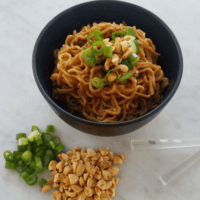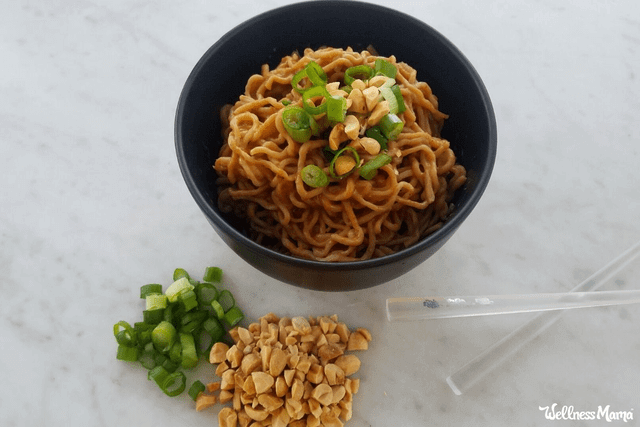When my family stopped eating grains, one of the hardest things to give up was pasta (my husband is Italian after all!). This Thai peanut butter noodles recipe uses shirataki noodles so we can stick to our grain-free lifestyle while still enjoying the finer things in life!
What Are Shirataki Noodles?
Shirataki noodles are completely grain free, making them an amazing ingredient when you’re craving pasta, but don’t want to eat grains. They are made from the glucomannan fiber of the konjac yam and have been used in Japanese cooking for generations.
These noodles are translucent and thin, which is where the name shirataki, meaning waterfall, came from. These noodles are not only grain free but low carb as well. It sounds too good to be true, but shirataki noodles really are a healthy food.
These noodles have practically no taste on their own, though they can smell a bit fishy straight out the bag (rinsing them removes the smell).
Some versions of shirataki noodles have added ingredients like soy, so be careful to read the label on whichever brand you choose.
Benefits of Shirataki Noodles
There are some potential health benefits to eating shirataki noodles. The glucomannan fiber in shirataki noodles is a viscous fiber, meaning it absorbs water and makes a gel. This helps it move through the digestive system slowly. Viscous fiber acts as a prebiotic, feeding the beneficial bacteria in your gut.
Shirataki noodles and other foods containing the fiber glucomannan are often recommended for weight loss as well.
How to Make Thai Peanut Butter Noodles
This recipe is so simple to make that my kids often help me make it or do it on their own. Here are the basic steps:
- Rinse and boil the noodles, then let them drip dry.
- Next, saute the noodles in a skillet to remove some of the water.
- Then mix together the sauce ingredients and add it to the skillet, cooking for another few minutes.
Top with green onions and chopped peanuts to serve.

Thai Peanut Butter Noodles Recipe (with Shirataki)
Servings
Ingredients
- 14 oz angel hair shirataki noodles
- ½ cup chicken broth
- 1 TBSP fresh ginger (minced)
- ¼ cup coconut aminos (or wheat-free tamari)
- ¼ cup peanut butter
- 2 TBSP honey
- 2 tsp chile paste (optional)
- 3 cloves garlic (minced)
- ¼ cup green onions (chopped)
- ¼ cup peanuts (chopped)
Instructions
- Rinse the shirataki noodles well in cool water.
- Bring a pot of water to a boil and boil the noodles for 3 minutes.
- Strain the noodles.
- Transfer the noodles to a dry skillet and cook on high for a few minutes to let some of the water evaporate (see note below).
- While the noodles are cooking, whisk together the broth, ginger, coconut aminos, peanut butter, honey, chili paste, and garlic in a bowl.
- Add the sauce mixture to the skillet with the noodles and stir until heated through.
- Top with green onions and toasted peanuts and serve.
Nutrition
Notes
How to Serve Thai Peanut Butter Noodles
This recipe doesn’t include much in the way of protein or vegetables, so I add grilled, roasted, or sauteed veggies and chicken to the noodles. I use whatever veggies I have on hand. In the summer I use zucchini, summer squash, and green beans. I’ve also roasted Brussels sprouts, beets, and other hearty vegetables.
Other times I choose another favorite dish or two to serve with the noodles. Here are my favorite combinations:
- Asian Color Burst Salad – This colorful salad is so beautiful to look at that my kids even love it. It’s full of flavor and nutrition making it a great pairing for noodles.
- Pad Krapow Gai – This Thai basil chicken is a quick dish full of flavor but not too spicy. It’s a perfect protein choice to serve with noodles.
- Grilled Thai Shrimp Recipe – One of my favorite recipes, this shrimp dish is easy to whip up and perfect for a protein alongside the noodles.
- Thai Chicken Curry – Make this recipe in the Instant Pot for a quick meal that tastes amazing.
- Thai Squash Curry – If you’re looking for a meatless Thai dish to serve with your noodles, this squash curry is perfect. It includes all of the flavors of Thai curry without meat.
What are your favorite Thai-inspired dishes? Have you ever used shirataki?


Leave a Reply